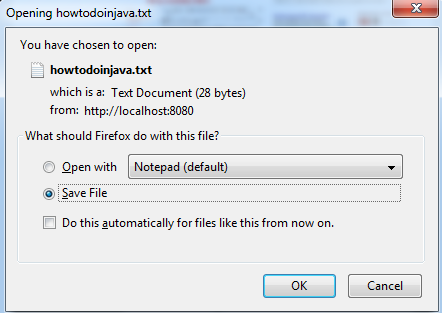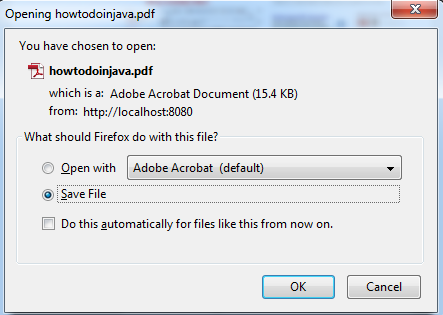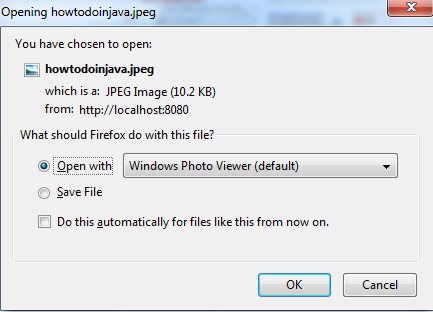RESTEasy is JBOSS provided implementation of JAX-RS specification for building RESTful Web Services and RESTful Java applications. RESTEasy works in combination with HTTP media types for providing the response in specific formats such as images, pdf or text.
The core component to configure for enabling support for multiple media types in response is @Produces annotation. A full list of such media types can be found in this link.
For demonstration purpose, I will be showing example of downloading one image, one text and one pdf file. Similarly you can build for other media types (file types).
1) Create a maven project
mvn archetype:generate -DgroupId=com.howtodoinjava -DartifactId=RESTfulDemoApplication -DarchetypeArtifactId=maven-archetype-webapp -DinteractiveMode=false mvn eclipse:eclipse -Dwtpversion=2.0
2) Update jax-rs dependencies in pom.xml file
<project xmlns="http://maven.apache.org/POM/4.0.0" xmlns:xsi="http://www.w3.org/2001/XMLSchema-instance"
xsi:schemaLocation="http://maven.apache.org/POM/4.0.0 ;
<modelVersion>4.0.0</modelVersion>
<groupId>com.howtodoinjava</groupId>
<artifactId>RESTfulDemoApplication</artifactId>
<packaging>war</packaging>
<version>1.0-SNAPSHOT</version>
<name>RESTfulDemoApplication Maven Webapp</name>
<url>http://maven.apache.org</url>
<repositories>
<repository>
<id>jboss</id>
<url>http://repository.jboss.org/maven2</url>
</repository>
</repositories>
<dependencies>
<!-- core library -->
<dependency>
<groupId>org.jboss.resteasy</groupId>
<artifactId>resteasy-jaxrs</artifactId>
<version>2.3.1.GA</version>
</dependency>
<dependency>
<groupId>net.sf.scannotation</groupId>
<artifactId>scannotation</artifactId>
<version>1.0.2</version>
</dependency>
</dependencies>
<build>
<finalName>RESTfulDemoApplication</finalName>
</build>
</project>
3) Create service class and APIs with corresponding media types in @Produces annotation
package com.howtodoinjava.service;
import java.io.File;
import javax.ws.rs.GET;
import javax.ws.rs.Path;
import javax.ws.rs.PathParam;
import javax.ws.rs.Produces;
import javax.ws.rs.core.Response;
import javax.ws.rs.core.Response.ResponseBuilder;
import javax.ws.rs.core.Response.Status;
@Path("/file-management")
public class FileServer
{
@GET
@Path("/{fileName}/text")
@Produces("text/plain")
public Response getFileInTextFormat(@PathParam("fileName") String fileName)
{
System.out.println("File requested is : " + fileName);
//Put some validations here such as invalid file name or missing file name
if(fileName == null || fileName.isEmpty())
{
ResponseBuilder response = Response.status(Status.BAD_REQUEST);
return response.build();
}
//Prepare a file object with file to return
File file = new File("c:/demoTxtFile.txt");
ResponseBuilder response = Response.ok((Object) file);
response.header("Content-Disposition", "attachment; filename="howtodoinjava.txt"");
return response.build();
}
@GET
@Path("/{fileName}/pdf")
@Produces("application/pdf")
public Response getFileInPDFFormat(@PathParam("fileName") String fileName)
{
System.out.println("File requested is : " + fileName);
//Put some validations here such as invalid file name or missing file name
if(fileName == null || fileName.isEmpty())
{
ResponseBuilder response = Response.status(Status.BAD_REQUEST);
return response.build();
}
//Prepare a file object with file to return
File file = new File("c:/demoPDFFile.pdf");
ResponseBuilder response = Response.ok((Object) file);
response.header("Content-Disposition", "attachment; filename="howtodoinjava.pdf"");
return response.build();
}
@GET
@Path("/{fileName}/image")
@Produces("image/jpeg")
public Response getFileInJPEGFormat(@PathParam("fileName") String fileName)
{
System.out.println("File requested is : " + fileName);
//Put some validations here such as invalid file name or missing file name
if(fileName == null || fileName.isEmpty())
{
ResponseBuilder response = Response.status(Status.BAD_REQUEST);
return response.build();
}
//Prepare a file object with file to return
File file = new File("c:/demoJpegFile.jpeg");
ResponseBuilder response = Response.ok((Object) file);
response.header("Content-Disposition", "attachment; filename="howtodoinjava.jpeg"");
return response.build();
}
}
4) Put files to be download in referenced locations
I am referencing files from “c:/<file>”. Copy files from distribution folder in download link, and paste them in c: before running this example.
5) Test the application
Below are snaps of download window appear in browser for requesting URLs:
http://localhost:8080/RESTfulDemoApplication/file-management/demoTxtFile/text

http://localhost:8080/RESTfulDemoApplication/file-management/demoPDFFile/pdf

http://localhost:8080/RESTfulDemoApplication/file-management/demoJpegFile/image

If you want to download sourcecode of above example, follow below given link.
Source code download
Happy Learning !!

Comments